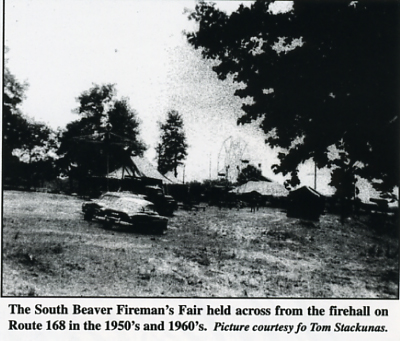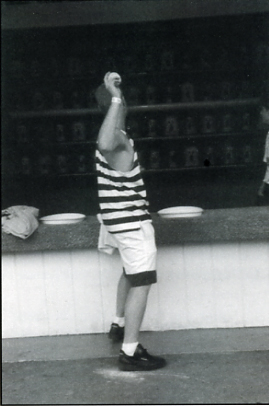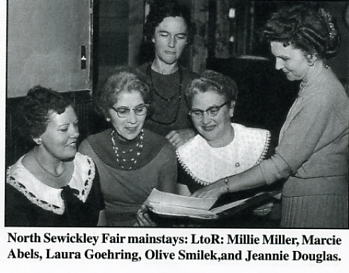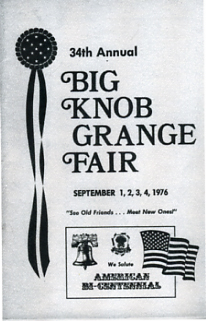
The Beaver County Fair Grounds in Beaver, 1899.
Click Here to Return to Milestones

There's nothing quite like that sweet fragrance
of cotton candy, popcorn or waffle cakes at the local fair. A
yardstick of genuine family values, it came in late summer when
it seemed as if every community back in those days had one.
Most are gone now. Many have departed due to
rising costs, the changes that have come over times or for other
reasons. Only three remain in Beaver County today: Big Knob in
New Sewickley Township, Hookstown in Greene Township and the ever-popular
Chippewa Firemen's Festival.
Sure there's street fairs here and there, but
there is nothing like the genuine article. Many a romance budded
on the fairgrounds too. "I know of at least a half dozen
that met their mate for life on the midway," Myron Elliott
of Hookstown laughed. "As a matter of fact," he continued,
"a wedding was held on the fair grounds 1907; they met here."
Charles Townsend, historian from Darlington
said, "The New Galilee fair was big for such a small town.
What a great time one could have there on a warm summer evening."
It was forced to shut down in the 1980s.
Denny Krebs mentioned that it began in 1929,
and took people's mind off the Great Depression for a couple hours.
It went on until World War II. "It started and stopped again
several times. We tried in 1999 and in 2000, but couldn't make
a go of it."
South Beaver Fair thrilled fans from the early 1960's to the early 1970's, according to Robert Long. The fair was held across from the fire station on Route 168. It was small but a great diversion for this farming community.

A spokesman for the Patterson Heights fair
said, "We lost most of our grounds due to the building of
a new school. So we had to cut down and do a smaller version,
but that closed in 1990."
At North Sewickley, I suppose my favorite treat was that pink cotton candy. I have nothing but fond memories of Mrs. Fred Teets rolling up another cone of that sticky stuff. But then, a bigger guy would get it for his girl and my grin turned to a frown. I'm sure that many of us remember being mesmerized by that machine.

Carol Senior-Vogler recalls working at the
refreshment stand making "suicides." She describes them
as being four kinds of pop mixed together. They were real popular
though. She now marvels, "You know I was only 12 or 13 years
old and they trusted us kids, not only with money, but, to give
the right change." After the fair was history, she grinned,
"I went bleacher to bleacher at the Rodeo selling 10-cent
snow cones."
And, who can forget those games of chance? They include tossing
a basketball, trying to knock over those silver milk bottles and
snaring a little yellow duck from that trough.
Ray Riles, owner-operator of Giles Country Market explained that
he liked to toss the hoop over the live duck's heads. "I
was a farm kid all the way. If you managed to do it, you got to
keep the ducks."
"The trouble is they were the kind that
could fly. We put 'em in a pen, and the next morning it was empty,"
he sighed. "The last time I saw them, they were heading for
the river."
Yours truly played safe and went for the little ducklings. That
was a prize every time. I'm sure mom liked the rubber snakes,
tom-toms and whistles I'd bring home.

Then there was that poor guy in the water tank.
He'd be nervously watching as we made like Vernon Law or Elroy
Face, firing a "must pitch" toward that arm and target
which sent him down under.
And how about the fellow who guessed your weight?
Generally sporting suspenders, he'd make sure our pockets were
empty before he'd predict. Win by say more than three pounds,
and you'd be the proud owner of a prize. Strange, but seldom were
the big prizes such as stuffed animals given out.
As the years went by, and the fair-goers got
older, the strapping youth would try to win that big teddy bear
for that special someone, usually a pretty gal cheering him on.
After a half-hour and lots of quarters later, the bear was theirs.
It was only about three times the price they would have paid for
it if they had bought it at the store. But it was the principle
of the thing, right?
Bella Douglass orchestrated the idea of holding
a fair in North Sewickley. The first few were held in the Grange
Hall near what was then Marr's Market. It is now Paul's. Former
Grange master Harold Douglass reported, "Exhibits, quilting
displays, baked goods, etc. were on the main floor. Dinners were
prepared and served in the basement. For example, a baked ham
dinner with scalloped potatoes, yellow beans, tossed salad and
pie a la' mode sold for $1.75. Oh, that included coffee or iced
tea too.
"It was popular and well attended,"
Harold Douglass pointed out. "The Volunteer Fire Department
across the highway was asked to join. So, we held it in big tents
behind the fire hall." That didn't turn out to be a good
move. The two groups then argued about chairman, committees and
money.
Another factor that I think contributed to
its downfall was when President Dwight Eisenhower in 1959 restructured
the highway system. His administration designated that all north-south
routes be odd numbered, while highways going east-west would be
even numbered digits. The main route from Beaver Falls stayed
588 as it was an east-west highway, but our Route 88 became Highway
65.
A Curious Aside--There's a piece in the North
Sewickley Township Bicentennial that leaves one shaking his head.
It seems that a man, years ago, reportedly found a two foot vein
of silver over 80 acres. He coyly covered it up again so others
wouldn't stake a claim. But, before he could make arrangements
to mine it himself, he was killed. His secret went with him. Fact
or urban legend? We'll probably never know.
But, back to the fairs. My own most vivid memory
was running from tent to tent picking up the valuable "freebies"
from the different vendors. The pavilions would be filled with
representatives from hardware stores, auto dealers, farm implement
stores and the like. I get misty- eyed when I think of those big
green and white Mellon Bank calendars ripe for the picking.
The well-dressed men would stand behind a table
of "goodies." Most would fold their arms behind their
backs. Now, that I think about it, I "kinda" wonder
if that was their way to control themselves and not wringing our
puny little necks. We'd race back and forth across the aisle grabbing
free pencils, balloons, yardsticks, auto trash bags, paint stirrers
or whatever they were giving away. It was like Christmas!
These were the days of friendly "Mom and
Pop" type stores. Quite often, we'd know the person at the
table. It was a time of much public pride and community support.
The vast Wal-Mart's, fast food joints, Home Depots and other impersonal
mega-stores where still in the future ---------thank god!
Harold Douglass explained that when our fair
ran, "It was the right time and the right place, for one
thing." He grinned, "We were all younger. The grange
was made up of a lot of strong farmers and the firemen had lots
of vim and vinegar." The event, which included 12 acres,
also had livestock competition and projects made by members of
the 4-H Club, boy and girl scouts. This was real quality time.
And, who can forget the rides? It was far from
today's costly theme parks, but we had as much fun. They'd include
a train for the younger kids to ride on, a music- playing merry-go-round,
a tilt-a-whirl and a tall Ferris wheel that always stopped when
you were at the very tip-top. Pony rides and a petting zoo were
both a "must." That tug-of-war with a barrel on a line
being splashed back and forth would bring out the laughs too.
Speaking of laughter, a smiling Ray Abels asked,
"Do you remember trying to straddle the ruts when parking
cars? Ha, we'd be given coupons for a hot dog and drink."
This writer also remembers the quagmire in the dirt lot should
it rain. "Yeah," Pete Brown of Brown's auto repair on
Concord Circle said, "I remember having to tow several people
out. We'd be there with our tow trucks anyway, waiting for the
demolition derbies."
We kids didn't worry about the "cold war"
at all these nights. It'd just have to wait as we were having
too much fun. This was also where I had to squeeze my way through
a large throng to see this new fangled thing that had rabbit ears.
I guessed it was a rare electronic animal, but I saw the strangest
device. I heard adults say the guy on the fuzzy black and white
screen was from Pittsburgh! Yeah, right!
Oh, we may not have had Bob Hope, John Wayne
or any other big names, but we didn't care. The Rochester Tumbling
Team was there along with an all- girl fife and drum corps from
Meridian. The big Beaver Falls Band (this was before Riverside
and Blackhawk) appeared. We even had a choral group from Midland.
Abbie Neal of WDTV (Dumont) was there later.
Harold Douglass noted that the local North
Sewickley fair was tailored after "Big Knob" festivities.
And, those folks apparently know a thing or two as they just held
their 63rd this year.
"Big Knob actually began 65 years ago," Hilda Pflug of the fair board explained. "We had to cancel one due to World War II and another time when the turnpike came through in 1950 and built their road through our fair grounds and forced us to move to our present site." The fair, sponsored by grange 2008, gets much public support, Harold Douglass conveyed.

But, the record for the oldest active fair in the County goes down to Greene Township. Myron Elliott, spokesman, specified that the Hookstown Fair's forerunner, "The Mill Creek Valley Fair began in a 15 acre field in 1885. It was incorporated in 1886." Thus, many of the first fair goers had to make the trip in hay wagons. Some came across the river and had to take Cook's Ferry over to what was State Route 243 (now Rt. 168). A newspaper story pointed out that the lineup waiting turns to cross the river extended for a mile or more.

"Later in 1905," Elliott disclosed,
"the fair was reorganized into the Hookstown Fair. It was
held across the road from where it's now located. They didn't
have it for awhile but restarted it in 1947, at the present 70
acre site owned by the grange."
Elliott added that it's being expanded and
now includes a one-room schoolhouse, a fully operational blacksmith
shop and a log cabin.
Elliott, in closing, remarked: "A fair-goer that's really interested in this area's history and background should stop by what we call the community tent which includes hundreds of photographs." He also praised the 4-H Club, "They've been a lot of help in making the fair a success."

However, the original Beaver County Fair goes
back even further. It was held each year from 1853 to 1898 at
the east end of Beaver. This would be the area where Bert's Wooden
Indian restaurant and the Beaver County Times office are located
today. It was forced to cancel in 1862 when confederate General
Robert E. Lee was invading the north. Harness races were the main
attraction and the spectators not only filled the grand stands
but also watched elbow-to-elbow over the fence enclosing the track.
It was said to be so popular that special trains
from both the P. & L. E. and Pennsylvania railroads were run.
Also, hundreds of fair-goers would pay their two-cent toll at
the bridge and come across from the other shore. They'd happily
climb the small hill to watch the festivities.
The April 18, 1968 issue of the News North
made the statement, "that the rides included a horse or donkey
powered merry-go-round." The animals would slowly walk in
circles while the lucky riders would try and grab that brass ring.
A concession was also, "available for those who came to spend
the day."
Family passes sold for $1.00. Ribbons were
given for livestock, knitted articles, quilts, and other displays.
The first joint North Sewickley Township fair was held Wednesday
August 13, through Saturday August 16, 1952. According to the
Beaver County Times, the last reported event was held in 1965.
The fire department didn't keep records a spokesman told me.
Janet May- Copeland recalls that she went there
often while growing up. "My biggest thrill was when Patty
Bonnage opened it, riding down the midway standing on two horses,
Annie Oakley style." "Yes," Darlene Homer agrees,
"she was quite the rider." Patty, daughter of historian
Bob Bonnage, married and is a schoolteacher.
When reached, Patty Sporka(Bonnage) offers
that the demise of the fair, "was just a case of changing
times. Televisions and other forms of entertainment have come
in." Ray Abels, who parked cars and was a presenter, pointed
out that, "We just weren't getting live- stock anymore. The
farms were on the way out and if the pickings were slim, it's
hard to attract the big buyers. A&P, Armour Star, Swift and
the others weren't either coming or giving good prices anymore."
He did find more than a buyer for his live-
stock though. He met Sally Scott; a romance bloomed, and four
children, nine grandchildren, and eleven great- grandchildren
later, they still reside on a farm just over the hill from where
they met in 1958. That was also the year Ray Giles met Judy Garvin.
They had three children, eleven grandchildren and four great-
grandchildren.
Olive Smilek surmises that, "Orrin Swick
being killed also put a damper on things." "Yes,"
Ray Giles stated, "I'll never forget being there that day.
Everything got deathly quiet." The popular 39-year old and
father of four was working as a volunteer at the time, working
on a transformer when the deadly accident occurred.
As mentioned earlier, another insidious factor
also eroded this popular event.
Harold Douglass, a North Sewickley icon, blames
politics and discord as being the "main culprits." The
grange members and firemen got to "fighting" as who
the chairperson would be or who would serve on what committee."
Olive, who has been a member of the auxiliary since its inception
in February 1940, agreed.
Fred Teets, the oldest active firemen at 76
years young, added, "We even built a big corral behind the
fairgrounds, but that didn't last long." Joyce Barnhart Woroszylo
can tell you exactly how long it lasted. "It was 1969. I
was very pregnant and can remember those hard seats and that hot
unrelenting sun," the Brighton Hot Dog Shoppe employee sighed.
It is fitting that a girl's softball complex is there now though,
keeping the screams alive. But, the fair memories are fading away.
The circus came to the county at various times
too.
Keith Blaho remembers one in Beaver Falls.
"My mother had $10 and seven of us went," he chuckled.
"We got orange drink and peanuts to drop them into the elephants
trunks." Other circuses were held at Junction Park, New Brighton.
A Wild West Show, today's rodeo, was held in
1910 on a field were the swimming pool is in upper Beaver Falls.
Hundreds arrived by trolley to see Buffalo Bill and Annie Oakley
performed. Hundreds more watched the parade up Seventh Avenue
led by Bill Cody himself and Miss Oakley, who could hit dimes
in the air.
Another was held May 10, 1937 with one of my
favorite cowboy stars, Hoot Gibson, being the main attraction.
Reports say the fete included stunt riders, trapeze artists, tumblers
and tight-wire walkers, "in an almost unending procession
of thrills and feats of daring." Elmer the elephant was also
a big draw.
A three-ring affair was held as recently as
June 1999 at the old Spotlight 88 drive-in grounds. The Robert
bothers put on an exciting two-day, three-show run under a big
blue and white tent.
Another was held recently under a red-and-yellow
big top, at Hopewell Plaza.
I've saved this last circus on purpose. Some
Beaver Countians might cringe when they think back 61 years ago
to when the King Brothers visited the New Sheffield grounds in
Hopewell Township. The pre-news release looked impressive, however
the stop over proved to be a disaster.
No one paid much attention to the grand stands
swaying as spectators clamored to seats. Just as the show began,
a loud cracking noise was heard. Thinking it was a normal circus
sound, the fans watched on. In a matter of seconds, the seats
collapsed. Stunned, the crowd raced out stampeding over others.
There were more than 60 persons injured.
Management used stalling tactics when patrons
demanded their money back. As officials began writing out 50 word
receipts, the lights "accidentally" went out. Three
days later, several spectators were still in hospitals, but it
also came out that King Brothers did not carry liability insurance.
Four days later, the first lawsuit was filed.
The circus was impounded on June 6th as lawsuits soared.
The next day, after a mad cross-country chase, the King Brothers circus was overtaken only eight miles from the New York state line.
